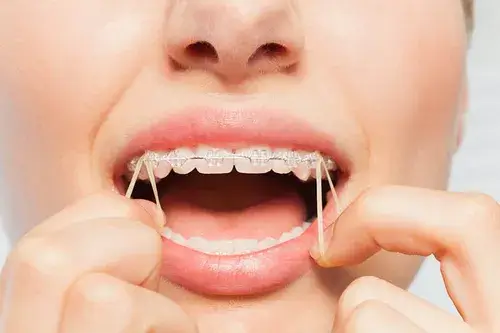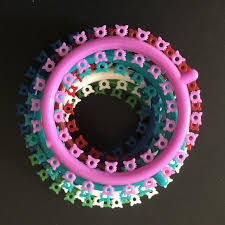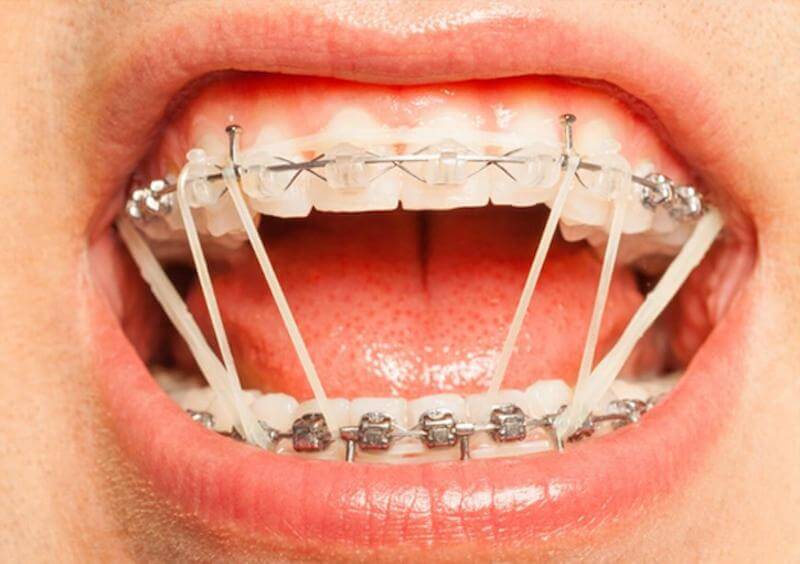How do braces elastic bands work?
Elastic bands in braces play an important and indispensable role in the process of adjusting teeth and jaws. To better understand their importance and how they work, let’s learn more about elastic bands in the braces process.

Function of elastic band
Elastic bands are a core component of orthodontic appliances. They are used to connect brackets on teeth and create a bond between the brackets of the upper and lower jaw. When placed in the correct position and specific tension, the elastic band creates a force system that acts on the teeth and jaw, thereby adjusting the position of the teeth.
Elastic bands help correct many teeth-related problems, including protruding teeth, crooked teeth, underbites, and more. They play an important role in shaping a beautiful smile and oral health.
Elastic band flexibility
The elastic band in the braces instrument is designed to ensure flexibility and elasticity. This means that they have the ability to stretch and contract without damage. This flexibility allows them to create specific tension and pressure on the teeth to adjust their position.

–Elastic band adjustment
The elastic band needs to be adjusted and changed at regular intervals according to the instructions of the braces specialist. This ensures that the force acting on the teeth takes place properly and strictly according to the treatment plan. The elastic band must be properly tightened, not too stretched or too loose, to ensure effectiveness in correcting teeth.
Tooth adjustment process
Tooth adjustment process When you start the braces process, your dentist will use elastic bands to create traction and push on each tooth. This helps the tooth binding move from its original position to its new position safely and efficiently. Elastic bands also play an important role in maintaining the new position of the teeth after the braces are complete.

-Commonly used braces elastic bands
In the process of braces, there are many types of elastics and options that you can choose from. These elastics are not only functional in adjusting the position of teeth but also provide aesthetics and color diversity. Below, we will learn about some common types of elastic that you may encounter with braces.
Elastic tied braces: This is a common and familiar type of elastic in the process of braces. Braces are used to connect braces with elastic bands, creating pressure to ensure teeth move evenly and in the right direction. They are often used in the treatment of dents, foul teeth, misaligned teeth, and many other problems.

Interstitial elastic: This type of elastic is designed to create special pressure to extend the distance between the teeth. Interstitial elastic is used when it is necessary to create more space for tooth adjustment or when the teeth are too tight. They have strong elasticity, which effectively widens the space between teeth
Single elastic: This type of elastic is used to adjust the specific position of one tooth or several fixed teeth. Single elastic creates individual forces acting on the tooth to be adjusted, which improves the position of that tooth.

Elastic chain: Elastic chain is a type of elastic band used to connect braces and a series of teeth at the same time. They are especially useful when adjustments to multiple teeth or entire rows of teeth are required. Elastic string helps to simultaneously act on several teeth, adjusting them in the desired direction.

Endomandibular elastic: The endomandibular elastic is attached inside the mouth, almost anonymously. This helps preserve the aesthetics of the smile during tooth adjustment. This elastic is usually used when the sufferer wants to avoid the appearance of extramandibular elastic.
Interjaw elastic: This type of elastic is used to connect the upper and lower teeth, while adjusting the position of both jaws. They help improve the position of the upper and lower jaws, helping to ensure braces achieve optimal performance.

Elastics to close the joints of both jaws: This type of elastic is used to adjust the bite and position of the upper and lower jaw. Elastic closure of the two jaws helps solve problems related to teeth, such as misaligned jaws, wider lower jaw, and many other bite problems.

Each type of elastic has its own unique goals and features to help the dentist effectively align the patient’s teeth and jaw. Choosing the right type of elastic depends on the tooth condition and specific adjustment goals. A professional dentist will determine the appropriate type of elastic and the best treatment plan for each specific case.
Consulting and care
To ensure the effectiveness and health of your braces treatment, elastic band management and care is an important part of your oral care regimen. Rubber bands play an important role in adjusting the position of teeth and jaws, and to ensure this process works best, it is essential to follow instructions on the use and care of rubber bands.
One of the first important points you need to know is to remove the rubber band every time you brush your teeth or eat. This is to help you clean your teeth more effectively and avoid food plaque or bacterial plaque that creates oily teeth. If you skip removing rubber bands, plaque can easily build up and cause oral health problems, like cavities or gingivitis.

However, using rubber bands does not apply to everyone. Depending on the current condition of your teeth and jaw, as well as your dentist’s instructions, you may or may not be instructed to use rubber bands. This is completely normal and not all cases of braces require the use of rubber bands. A professional dentist will determine whether you need to use rubber bands or not, depending on your specific condition.
However, using rubber bands does not apply to everyone. Depending on the current condition of your teeth and jaw as well as your dentist’s instructions, you may or may not be instructed to use rubber bands. This is completely normal and not all braces require the use of rubber bands. A professional dentist will determine whether you need to use rubber bands or not depending on your specific condition.

Before starting the braces process, you need to listen to advice from a dentist to check your oral health status. This includes checking to see if you have any dental problems, any teeth that need to be extracted, or health problems such as diabetes, hemophilia, or other problems.
When eligible, you will have dental X-rays taken to observe the current condition of your teeth and plan appropriate treatment. Your doctor will advise you on the most suitable form of braces for your teeth and jaw condition.
Prestigious orthodontic dental address in Thu Dau Mot, Binh Duong
Tại nha khoa Nụ cười Duyên, We are committed to ensuring effectiveness in the braces process, helping you have a beautiful smile and comprehensive oral health.
👉 Bạn đã đến Nha Khoa Nụ Cười Duyên Bình Dương để niềng răng chưa?
Lý do bạn nên chọn Nha Khoa Nụ Cười Duyên để niềng răng của mình? Tại đây bạn sẽ được:
✅ Install braces from only 1 million/month.
✅ Warranty on braces results for 10 years.
✅ Take survey films before getting braces at Dental Clinic using modern imaging technology, absolutely safe for customers.
✅ Have a clear braces commitment contract.
✅ The Doctor has a certificate specializing in orthodontic braces and follows the braces process until the end.



